Oracle 11gR2 概念 第6章 数据字典和动态性能视图
- 格式:pdf
- 大小:386.61 KB
- 文档页数:11

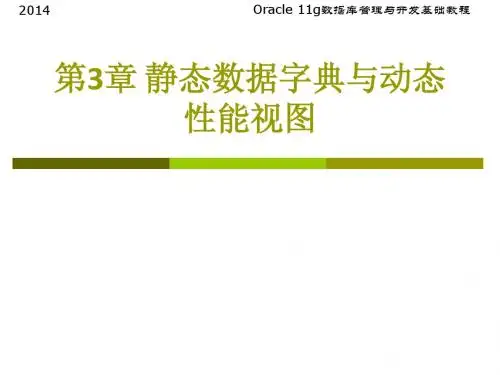
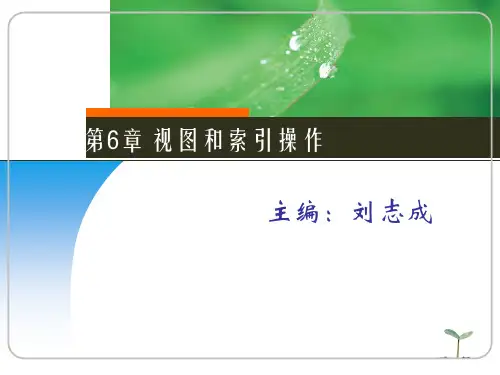
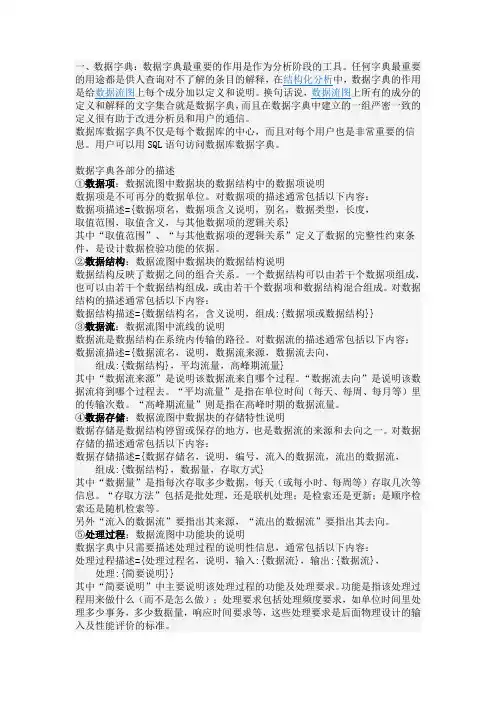
一、数据字典:数据字典最重要的作用是作为分析阶段的工具。
任何字典最重要的用途都是供人查询对不了解的条目的解释,在结构化分析中,数据字典的作用是给数据流图上每个成分加以定义和说明。
换句话说,数据流图上所有的成分的定义和解释的文字集合就是数据字典,而且在数据字典中建立的一组严密一致的定义很有助于改进分析员和用户的通信。
数据库数据字典不仅是每个数据库的中心,而且对每个用户也是非常重要的信息。
用户可以用SQL语句访问数据库数据字典。
数据字典各部分的描述①数据项:数据流图中数据块的数据结构中的数据项说明数据项是不可再分的数据单位。
对数据项的描述通常包括以下内容:数据项描述={数据项名,数据项含义说明,别名,数据类型,长度,取值范围,取值含义,与其他数据项的逻辑关系}其中“取值范围”、“与其他数据项的逻辑关系”定义了数据的完整性约束条件,是设计数据检验功能的依据。
②数据结构:数据流图中数据块的数据结构说明数据结构反映了数据之间的组合关系。
一个数据结构可以由若干个数据项组成,也可以由若干个数据结构组成,或由若干个数据项和数据结构混合组成。
对数据结构的描述通常包括以下内容:数据结构描述={数据结构名,含义说明,组成:{数据项或数据结构}}③数据流:数据流图中流线的说明数据流是数据结构在系统内传输的路径。
对数据流的描述通常包括以下内容:数据流描述={数据流名,说明,数据流来源,数据流去向,组成:{数据结构},平均流量,高峰期流量}其中“数据流来源”是说明该数据流来自哪个过程。
“数据流去向”是说明该数据流将到哪个过程去。
“平均流量”是指在单位时间(每天、每周、每月等)里的传输次数。
“高峰期流量”则是指在高峰时期的数据流量。
④数据存储:数据流图中数据块的存储特性说明数据存储是数据结构停留或保存的地方,也是数据流的来源和去向之一。
对数据存储的描述通常包括以下内容:数据存储描述={数据存储名,说明,编号,流入的数据流,流出的数据流,组成:{数据结构},数据量,存取方式}其中“数据量”是指每次存取多少数据,每天(或每小时、每周等)存取几次等信息。
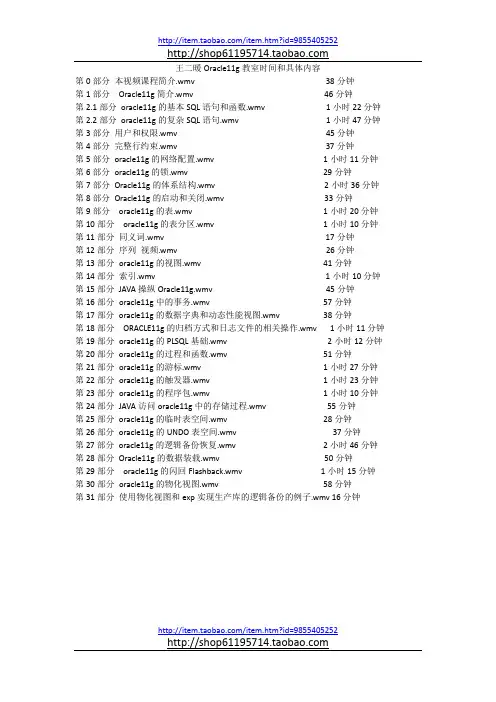
王二暖Oracle11g教室时间和具体内容第0部分本视频课程简介.wmv 38分钟第1部分Oracle11g简介.wmv 46分钟第2.1部分oracle11g的基本SQL语句和函数.wmv 1小时22分钟第2.2部分oracle11g的复杂SQL语句.wmv 1小时47分钟第3部分用户和权限.wmv 45分钟第4部分完整行约束.wmv 37分钟第5部分oracle11g的网络配置.wmv 1小时11分钟第6部分oracle11g的锁.wmv 29分钟第7部分Oracle11g的体系结构.wmv 2小时36分钟第8部分Oracle11g的启动和关闭.wmv 33分钟第9部分oracle11g的表.wmv 1小时20分钟第10部分oracle11g的表分区.wmv 1小时10分钟第11部分同义词.wmv 17分钟第12部分序列视频.wmv 26分钟第13部分oracle11g的视图.wmv 41分钟第14部分索引.wmv 1小时10分钟第15部分JAVA操纵Oracle11g.wmv 45分钟第16部分oracle11g中的事务.wmv 57分钟第17部分oracle11g的数据字典和动态性能视图.wmv 38分钟第18部分ORACLE11g的归档方式和日志文件的相关操作.wmv 1小时11分钟第19部分oracle11g的PLSQL基础.wmv 2小时12分钟第20部分oracle11g的过程和函数.wmv 51分钟第21部分oracle11g的游标.wmv 1小时27分钟第22部分oracle11g的触发器.wmv 1小时23分钟第23部分oracle11g的程序包.wmv 1小时10分钟第24部分JAVA访问oracle11g中的存储过程.wmv 55分钟第25部分oracle11g的临时表空间.wmv 28分钟第26部分oracle11g的UNDO表空间.wmv 37分钟第27部分oracle11g的逻辑备份恢复.wmv 2小时46分钟第28部分Oracle11g的数据装载.wmv 50分钟第29部分oracle11g的闪回Flashback.wmv 1小时15分钟第30部分oracle11g的物化视图.wmv 58分钟第31部分使用物化视图和exp实现生产库的逻辑备份的例子.wmv 16分钟具体课程目录如下:第1部分Oracle11g简介1.1 Oracle的发展1.2 Oracle的主要产品1.3 为什么要学习Oracle11g1.4 Oracle11g简介1.5 Oracle11g的认证1.6 Oracle11g的安装(for Windows)1.7 Oracle11g的服务1.8 Oracle11g的卸载1.9 访问Oracle11g的工具1.10 Oracle11g常用的SQL*Plus命令1.11 Oracle11g的网络配置第2.1部分Oracle11g的基本SQL语句和函数2.1.1 Oracle的数据类型2.1.2 数据定义语言2.1.3 数据操纵语言2.1.4 SELECT命令详解2.1.5 Oracle中的CREATE TABLE <new_table_name> AS ...和insert into <table_name> select ...的使用2.1.6 数据控制语言2.1.7 SQL操作符2.1.8 Oracle的单行函数2.1.9 GROUP BY和HAVING子句的使用2.1.10 多表连接的方式2.1.11 集合操作符2.1.12 表和列的重命名第2.2部分Oracle11g的复杂SQL语句2.2.1 SQL语句执行顺序的分析2.2.2 EXISTS执行过程的分析2.2.3 子查询的使用2.2.4 GROUP BY的练习2.2.5 自连接的使用2.2.6 SELECT CASE WHEN的的使用2.2.7 复杂更新语句的使用(UPDATE执行过程的分析)2.2.8 分析函数的使用2.2.9 DECODE的使用2.2.10 Oracle中的行列转换2.2.11 ROWNUM的使用2.2.12 使用三种SQL命令来删除表中的重复记录2.2.13 GROUP BY GROUPING SETS 的使用第3部分用户和权限管理3.1 Oracle11g的默认用户3.2 创建新用户3.3 概要文件profile的使用3.4 Oracle11g的权限分类3.5 Oracle11g的系统权限3.6 Oracle11g的对象权限3.7 Oracle11g的角色管理3.8 删除、修改用户第4部分完整行约束4.1 举例说明数据完整性的含义4.2 维护数据完整性的五种方式的举例说明4.3 建立主键的五种不同方式4.4 完整性约束的习题讲解4.5 给已有表添加、删除约束的方法第5部分Oracle11g的网络配置5.1 Oracle11g的网络连接方式5.2 Oracle11g至少需要启动的服务5.3 lsnrctl命令的使用5.4 sqlnet.ora的作用5.5 客户端连接的两种方式5.6 tnsnames.ora的作用5.7 Oracle11g的服务名的含义5.8 listener.ora的作用5.9 静态注册、动态注册的含义及其相互转化的方式第6部分Oracle11g的锁6.1 锁的概念和优点6.2 行级锁6.3 表级锁的五种方式6.4 死锁第7部分Oracle11g的体系结构7.1 Oracle11g的主要组件7.2 Oracle11g内存结构7.3 Oracle11g的SGA的组成7.4 Oracle11g的PGA的组成7.5 Oracle11g的进程概念7.6 Oracle11g的后台进程7.7 9i中的自动PGA管理7.8 10g中的自动SGA管理7.9 11g中的自动内存管理7.10 Oracle11g的物理文件7.11 Oracle11g的逻辑结构第8部分Oracle11g的启动和关闭8.1 Oracle11g的参数文件8.2 Oracle11g的四种状态8.3 Oracle的启动8.4 Oracle的关闭第9部分Oracle11g的表9.1 术语----高水位线9.2 术语---- PCTFREE9.3 术语---- PCTUSED9.4 PCTFREE和PCTUSED的使用场合9.5 普通表(包含分配空间、移动表、收缩表、截断表等操作的方式)9.6 IOT表9.7 簇表9.8 临时表第10部分Oracle11g的表分区10.1 表分区的含义10.2 范围分区10.3 散列分区10.4 列表分区10.5 复合分区10.6 Oracle11g的引用分区10.7 Oracle11g的间隔分区10.8 Oracle11g的基于虚拟列的分区10.9 Oracle11g的系统分区10.10 分区的维护操作第11部分同义词11.1 同义词的含义11.2 共有同义词的建立和使用11.3 私有同义词的建立和使用11.4 tab是什么?第12部分序列12.1 序列的含义12.2 建立序列(包括重要参数的含义)12.3 访问序列12.4 更改、删除序列12.5 程序中如何实现自增第13部分Oracle11g的视图13.1 Oracle11g中创建视图的语法13.2 多表视图的建立13.3 单表视图的更新13.4 视图上的DML语句13.5 视图中的函数第14部分索引14.1 索引的概念和作用14.2 B树索引的工作原理(查询过程分析)14.3 创建标准索引14.4 如何分析索引中是否存在碎片和使用率14.5 创建唯一索引、组合索引、反向键索引、位图索引14.6 基于函数的索引14.7 重建索引的条件和方法14.8 索引的分区14.9 获取索引信息的视图第15部分JAVA操纵Oracle11g15.1 Oracle11g的驱动所在的位置15.2 ODBC访问方式15.3 JDBC-ODBC桥访问方式,输入Java代码演示15.4 JDBC访问方式,输入Java代码演示第16部分Oracle11g中的事务16.1 举例说明事务的四个特性16.2 Oracle11g事务的命令(与SqlServer进行对比)16.3 JAVA中进行oracle11g的事务处理(举2个经典例子,输入Java代码演示)第17部分Oracle11g的数据字典和动态性能视图17.1 Oreacle11g中的数据字典的含义是什么17.2 数据字典基本表怎么被创建的17.3 数据字典视图是什么?怎么被创建的17.4 Oracle11g的数据字典视图的三种类型(分析user_tables究竟是什么)17.5 Oracle11g的动态性能视图(分析V$SESSION究竟是什么)第18部分Oracle11g的归档方式和日志文件的相关操作18.1 在线日志文件的作用18.2 数据库归档方式的转换18.3 Oracle11g的归档日志位置的设置18.4 归档中,被废弃的早期的初始化参数18.5 联机日志文件和联机日志文件组18.6 联机日志文件组的四种常见状态18.7 增加、清除联机日志文件18.8 自动归档、手工归档第19部分Oracle11g的PL/SQL基础19.1 PL/SQL简介19.2 PL/SQL 块的结构19.3 变量和常量(与T-SQL进行比较)19.4 PL/SQL中的数据类型(包含Oracle11g中新增的类型)19.5 如何把大文件保存到表BLOB列中19.6 如何把大内容保存到表的CLOB列中19.7 Oracle11g新特性:无dual的序列19.8 PL/SQL中的流程控制结构(重点讲循环的几种方式)19.9 Oracle11g新特性:continue语句的使用19.10 动态SQL的使用19.11 PL/SQL中的错误处理机制第20部分Oracle11g的过程和函数20.1 创建过程的语法20.2 过程参数的三种模式20.3 在两种方式下(Sql*Plus中和其他过程内),执行过程的方法20.4 执行过程的权限20.5 创建函数的语法20.6 函数的课堂题目和解答20.7 函数和过程的比较20.8 Oracle11g的自主事务处理第21部分Oracle11g的游标21.1 游标的简介和分类21.2 Oracle11g的隐式游标21.3 Oracle11g的显式游标21.4 Oracle11g的带参数的显式游标21.5 使用显式游标更新行(更新、删除)21.6 Oracle11g的循环游标21.7 使用fetch ... bulk collect into进行批量提取21.8 Oracle11g的REF游标21.9 显式游标、REF游标的课堂题目和分析解答第22部分Oracle11g的触发器22.1 触发器的作用22.2 创建触发器的语句(与SqlServer进行比较)22.3 for each row子句的含义22.4 after、before两种类型的触发器的区别22.5 instead of触发器的使用22.6 模式触发器的使用22.7 数据库启动、关闭触发器的使用22.8 用户登录、退出触发器的使用22.9 启用、禁用、查看触发器第23部分Oracle11g的程序包23.1 程序包的含义23.2 建立包规范23.3 建立包体23.4 程序包中游标的使用23.5 常用的内置程序包(dbms_output、dbms_random、utl_file、dbms_job等)第24部分JAVA访问Oracle11g中的存储过程24.1 java程序中调用Oracle11g中的没有返回参数的存储过程(插入记录)24.2 java程序中调用Oracle11g中的没有返回参数的存储过程(更新记录)24.3 java程序中调用Oracle11g中的有返回参数的存储过程(查询记录)24.4 java程序中调用Oracle11g中的返回列表的存储过程24.5 java程序中调用Oracle11g中的分页存储过程(存储过程返回分页的列表)第25部分Oracle11g的临时表空间25.1 Oracle11g中临时表空间的作用25.2 Oracle11g的临时表空间和临时表空间组25.3 oracle11g的临时表空间的操作第26部分Oracle11g的UNDO表空间26.1 9i到11g的Undo管理的方式改变26.2 UNDO块的作用26.3 UNDO表空间的作用26.4 Oracle11g的UNDO相关的重要参数26.5 Oracle11g的UNDO表空间的操作26.6 Oracle11g的UNDO表空间的新特性第27部分Oracle11g的逻辑备份恢复27.1 数据库备份、恢复简介27.2 Oracle环境中可能发生的故障类型27.3 传统的导出程序exp27.4 传统的导入程序imp27.5 可传输表空间27.6 11g的数据泵简介27.7 expdp的重要参数27.8 impdp的重要参数27.9 exp/imp与数据泵的区别第28部分Oracle11g的数据装载28.1 数据装载的使用场合和几种方式28.2 SQL*LOADER的使用28.3 外部表的使用第29部分Oracle11g的闪回Flashback29.1 Oracle9i的闪回查询29.2 Oracle10g的闪回版本查询29.3 Oracle10g的闪回事务查询29.4 Oracle10g的闪回表29.5 Oracle10g的闪回删除29.6 Oracle10g的闪回数据库第30部分Oracle11g的物化视图30.1 物化视图的发展、简介30.2 物化视图的作用30.3 创建物化视图的权限30.4 创建物化视图的选项30.5 基于主键的物化视图30.6 基于rowid的物化视图第31部分使用物化视图和exp实现生产库的逻辑备份的例子31.1 问题的提出31.2 问题的解决。
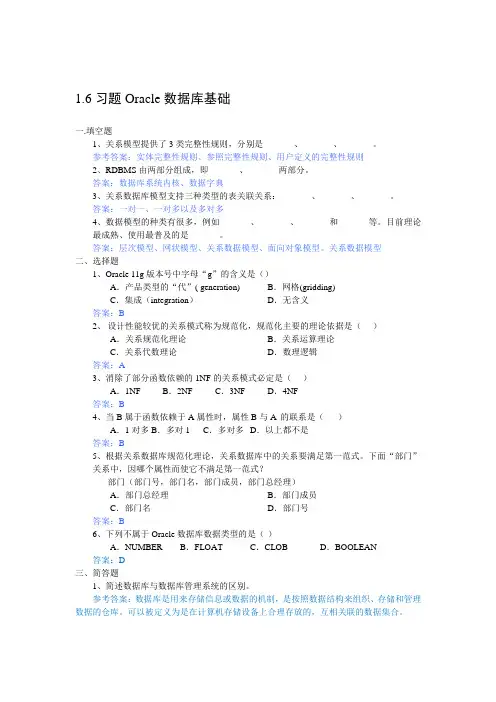
1.6习题Oracle数据库基础一.填空题1、关系模型提供了3类完整性规则,分别是_______、_______、_______。
参考答案:实体完整性规则、参照完整性规则、用户定义的完整性规则2、RDBMS由两部分组成,即_______、_______两部分。
答案:数据库系统内核、数据字典3、关系数据库模型支持三种类型的表关联关系:_______、_______、_______。
答案:一对一、一对多以及多对多4、数据模型的种类有很多,例如_______、_______、_______和_______等。
目前理论最成熟、使用最普及的是_______。
答案:层次模型、网状模型、关系数据模型、面向对象模型。
关系数据模型二、选择题1、Oracle 11g版本号中字母“g”的含义是()A.产品类型的“代”( generation) B.网格(gridding)C.集成(integration)D.无含义答案:B2、设计性能较优的关系模式称为规范化,规范化主要的理论依据是()A.关系规范化理论B.关系运算理论C.关系代数理论D.数理逻辑答案:A3、消除了部分函数依赖的1NF的关系模式必定是()A.1NF B.2NF C.3NF D.4NF答案:B4、当B属于函数依赖于A属性时,属性B与A 的联系是()A.1对多B.多对1 C.多对多D.以上都不是答案:B5、根据关系数据库规范化理论,关系数据库中的关系要满足第一范式。
下面“部门”关系中,因哪个属性而使它不满足第一范式?部门(部门号,部门名,部门成员,部门总经理)A.部门总经理B.部门成员C.部门名D.部门号答案:B6、下列不属于Oracle数据库数据类型的是()A.NUMBER B.FLOAT C.CLOB D.BOOLEAN 答案:D三、简答题1、简述数据库与数据库管理系统的区别。
参考答案:数据库是用来存储信息或数据的机制,是按照数据结构来组织、存储和管理数据的仓库。
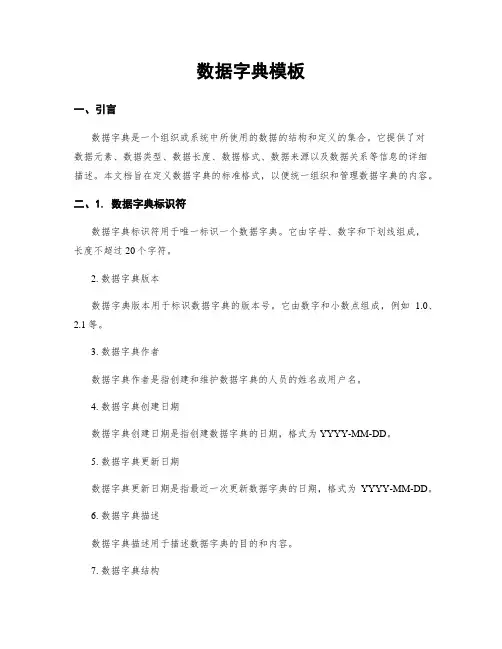
数据字典模板一、引言数据字典是一个组织或系统中所使用的数据的结构和定义的集合。
它提供了对数据元素、数据类型、数据长度、数据格式、数据来源以及数据关系等信息的详细描述。
本文档旨在定义数据字典的标准格式,以便统一组织和管理数据字典的内容。
二、1. 数据字典标识符数据字典标识符用于唯一标识一个数据字典。
它由字母、数字和下划线组成,长度不超过20个字符。
2. 数据字典版本数据字典版本用于标识数据字典的版本号。
它由数字和小数点组成,例如 1.0、2.1等。
3. 数据字典作者数据字典作者是指创建和维护数据字典的人员的姓名或用户名。
4. 数据字典创建日期数据字典创建日期是指创建数据字典的日期,格式为YYYY-MM-DD。
5. 数据字典更新日期数据字典更新日期是指最近一次更新数据字典的日期,格式为YYYY-MM-DD。
6. 数据字典描述数据字典描述用于描述数据字典的目的和内容。
7. 数据字典结构数据字典结构包括数据元素、数据类型、数据长度、数据格式、数据来源和数据关系等。
- 数据元素:数据元素是指一个数据项或数据对象的名称,例如"姓名"、"年龄"等。
- 数据类型:数据类型是指数据元素的类型,例如整数、字符、日期等。
- 数据长度:数据长度是指数据元素的长度,例如整数的长度为4字节。
- 数据格式:数据格式是指数据元素的显示格式,例如日期的格式为YYYY-MM-DD。
- 数据来源:数据来源是指数据元素的来源,例如数据库表、文件等。
- 数据关系:数据关系是指数据元素之间的关系,例如主键-外键关系。
8. 数据字典示例以下是一个示例数据字典的部分内容:数据字典标识符:EMPLOYEE数据字典版本:1.0数据字典作者:John Smith数据字典创建日期:2022-01-01数据字典更新日期:2022-02-15数据字典描述:该数据字典用于描述员工信息。
数据元素:员工编号数据类型:整数数据长度:4字节数据格式:无数据来源:数据库表"EMPLOYEE"数据关系:主键数据元素:员工姓名数据类型:字符数据长度:50字节数据格式:无数据来源:数据库表"EMPLOYEE"数据关系:无数据元素:员工年龄数据类型:整数数据长度:4字节数据格式:无数据来源:数据库表"EMPLOYEE"数据关系:无数据元素:员工性别数据类型:字符数据长度:1字节数据格式:无数据来源:数据库表"EMPLOYEE"数据关系:无数据元素:入职日期数据类型:日期数据长度:8字节数据格式:YYYY-MM-DD数据来源:数据库表"EMPLOYEE"数据关系:无数据元素:部门编号数据类型:整数数据长度:4字节数据格式:无数据来源:数据库表"EMPLOYEE"数据关系:外键,关联数据库表"DEPARTMENT"的主键"DEPT_ID"三、总结本文档定义了数据字典的标准格式,包括数据字典标识符、数据字典版本、数据字典作者、数据字典创建日期、数据字典更新日期、数据字典描述、数据字典结构等内容。
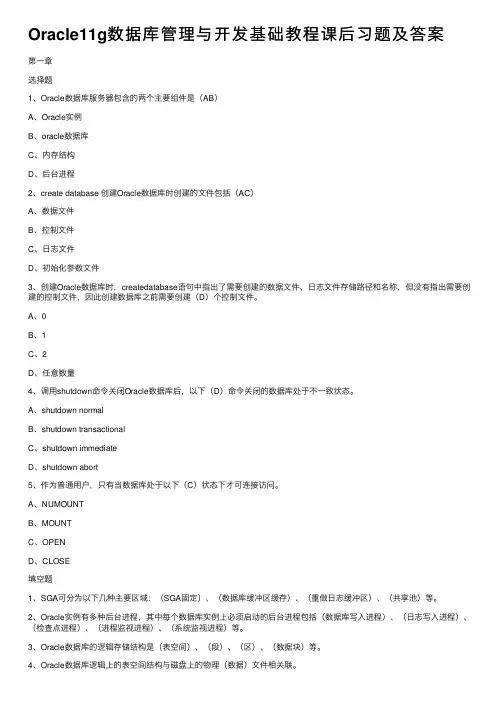
Oracle11g数据库管理与开发基础教程课后习题及答案第⼀章选择题1、Oracle数据库服务器包含的两个主要组件是(AB)A、Oracle实例B、oracle数据库C、内存结构D、后台进程2、create database 创建Oracle数据库时创建的⽂件包括(AC)A、数据⽂件B、控制⽂件C、⽇志⽂件D、初始化参数⽂件3、创建Oracle数据库时,createdatabase语句中指出了需要创建的数据⽂件、⽇志⽂件存储路径和名称,但没有指出需要创建的控制⽂件,因此创建数据库之前需要创建(D)个控制⽂件。
A、0B、1C、2D、任意数量4、调⽤shutdown命令关闭Oracle数据库后,以下(D)命令关闭的数据库处于不⼀致状态。
A、shutdown normalB、shutdown transactionalC、shutdown immediateD、shutdown abort5、作为普通⽤户,只有当数据库处于以下(C)状态下才可连接访问。
A、NUMOUNTB、MOUNTC、OPEND、CLOSE填空题1、SGA可分为以下⼏种主要区域:(SGA固定)、(数据库缓冲区缓存)、(重做⽇志缓冲区)、(共享池)等。
2、Oracle实例有多种后台进程,其中每个数据库实例上必须启动的后台进程包括(数据库写⼊进程)、(⽇志写⼊进程)、(检查点进程)、(进程监视进程)、(系统监视进程)等。
3、Oracle数据库的逻辑存储结构是(表空间)、(段)、(区)、(数据块)等。
4、Oracle数据库逻辑上的表空间结构与磁盘上的物理(数据)⽂件相关联。
5、下⾯连接字符串采⽤的是(简易连接)命名⽅式。
CONNECT Scott/tiger@dbs:1525@/doc/727db4ff03768e9951e79b89680203d8ce2f6aac.html编程题1.写出以下操作的SQL*PLUS命令语句:先启动Oracle实例到“已启动实例状态”,再修改Oracle实例到“数据库已装载状态”,最后修改Oracle实例到打开状态。
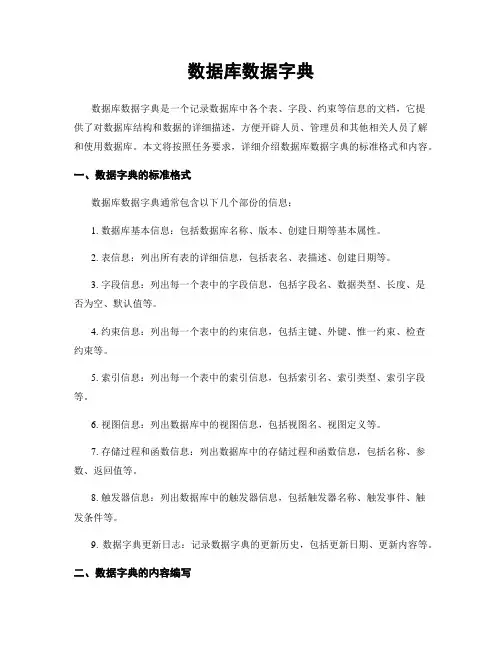
数据库数据字典数据库数据字典是一个记录数据库中各个表、字段、约束等信息的文档,它提供了对数据库结构和数据的详细描述,方便开辟人员、管理员和其他相关人员了解和使用数据库。
本文将按照任务要求,详细介绍数据库数据字典的标准格式和内容。
一、数据字典的标准格式数据库数据字典通常包含以下几个部份的信息:1. 数据库基本信息:包括数据库名称、版本、创建日期等基本属性。
2. 表信息:列出所有表的详细信息,包括表名、表描述、创建日期等。
3. 字段信息:列出每一个表中的字段信息,包括字段名、数据类型、长度、是否为空、默认值等。
4. 约束信息:列出每一个表中的约束信息,包括主键、外键、惟一约束、检查约束等。
5. 索引信息:列出每一个表中的索引信息,包括索引名、索引类型、索引字段等。
6. 视图信息:列出数据库中的视图信息,包括视图名、视图定义等。
7. 存储过程和函数信息:列出数据库中的存储过程和函数信息,包括名称、参数、返回值等。
8. 触发器信息:列出数据库中的触发器信息,包括触发器名称、触发事件、触发条件等。
9. 数据字典更新日志:记录数据字典的更新历史,包括更新日期、更新内容等。
二、数据字典的内容编写以下是一个示例数据库数据字典的内容,仅供参考:1. 数据库基本信息:- 数据库名称:CompanyDB- 数据库版本:MySQL 8.0- 创建日期:2022年1月1日2. 表信息:- 表名:Employee- 表描述:存储公司员工信息的表- 创建日期:2022年1月2日3. 字段信息:- 字段名:EmployeeID数据类型:INT长度:10是否为空:否默认值:无描述:员工ID- 字段名:FirstName数据类型:VARCHAR长度:50是否为空:否默认值:无描述:员工名字的姓氏- 字段名:LastName数据类型:VARCHAR长度:50是否为空:否默认值:无描述:员工名字的名字- 字段名:Email数据类型:VARCHAR长度:100是否为空:是默认值:NULL描述:员工的电子邮件地址 - 字段名:Salary数据类型:DECIMAL长度:10, 2是否为空:是默认值:NULL描述:员工的薪水4. 约束信息:- 主键:EmployeeID- 惟一约束:Email5. 索引信息:- 索引名:idx_EmployeeID索引类型:B-tree索引字段:EmployeeID- 索引名:idx_LastName索引类型:B-tree索引字段:LastName6. 视图信息:- 视图名:EmployeeView视图定义:SELECT EmployeeID, FirstName, LastName FROM Employee 7. 存储过程和函数信息:- 存储过程名:GetEmployeeByID参数:@EmployeeID INT返回值:无描述:根据员工ID获取员工信息的存储过程- 函数名:CalculateSalary参数:@EmployeeID INT返回值:DECIMAL描述:根据员工ID计算薪水的函数8. 触发器信息:- 触发器名:UpdateEmployee触发事件:BEFORE UPDATE触发条件:当更新Employee表中的Salary字段时9. 数据字典更新日志:- 更新日期:2022年1月3日更新内容:新增了存储过程GetEmployeeByID以上是一个简单的数据库数据字典的示例,实际的数据字典应根据具体的数据库和需求进行编写。
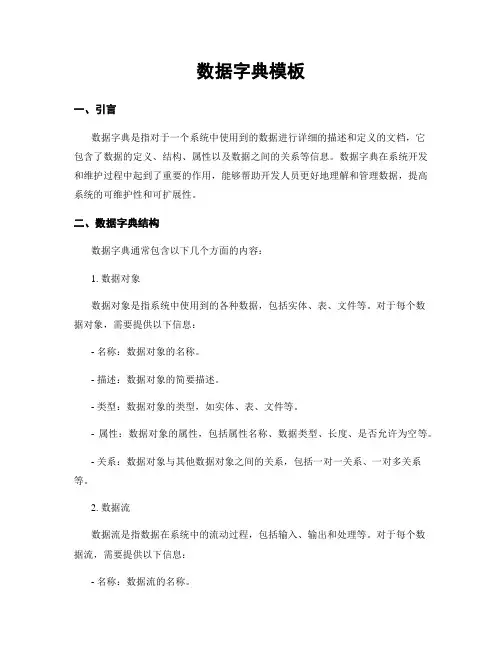
数据字典模板一、引言数据字典是指对于一个系统中使用到的数据进行详细的描述和定义的文档,它包含了数据的定义、结构、属性以及数据之间的关系等信息。
数据字典在系统开发和维护过程中起到了重要的作用,能够帮助开发人员更好地理解和管理数据,提高系统的可维护性和可扩展性。
二、数据字典结构数据字典通常包含以下几个方面的内容:1. 数据对象数据对象是指系统中使用到的各种数据,包括实体、表、文件等。
对于每个数据对象,需要提供以下信息:- 名称:数据对象的名称。
- 描述:数据对象的简要描述。
- 类型:数据对象的类型,如实体、表、文件等。
- 属性:数据对象的属性,包括属性名称、数据类型、长度、是否允许为空等。
- 关系:数据对象与其他数据对象之间的关系,包括一对一关系、一对多关系等。
2. 数据流数据流是指数据在系统中的流动过程,包括输入、输出和处理等。
对于每个数据流,需要提供以下信息:- 名称:数据流的名称。
- 描述:数据流的简要描述。
- 类型:数据流的类型,如输入、输出、内部等。
- 数据对象:数据流所涉及到的数据对象,包括输入的数据对象和输出的数据对象。
- 处理:数据流的处理过程,包括数据转换、数据计算等。
3. 数据存储数据存储是指系统中用于存储数据的各种设备和介质,包括数据库、文件、表等。
对于每个数据存储,需要提供以下信息:- 名称:数据存储的名称。
- 描述:数据存储的简要描述。
- 类型:数据存储的类型,如数据库、文件等。
- 数据对象:数据存储所包含的数据对象。
4. 数据处理数据处理是指系统对数据进行的各种操作和处理过程,包括数据的输入、输出、转换、计算等。
对于每个数据处理,需要提供以下信息:- 名称:数据处理的名称。
- 描述:数据处理的简要描述。
- 输入:数据处理的输入数据流。
- 输出:数据处理的输出数据流。
- 处理逻辑:数据处理的详细处理逻辑,包括数据转换、数据计算等。
5. 数据字典管理数据字典管理是指对数据字典进行维护和管理的过程,包括数据字典的创建、更新、查询和删除等操作。
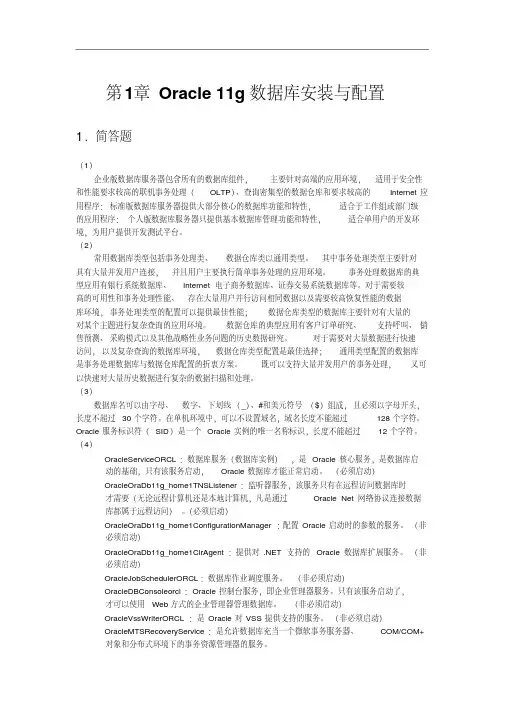
数据字典模板一、引言数据字典是一个记录和描述数据库中各个数据元素(包括表、字段、数据类型、长度、约束等)的文档,它为数据库的设计、开辟和维护提供了重要的参考依据。
本文档旨在提供一个标准的数据字典模板,以便统一规范和管理数据库中的数据元素。
二、数据字典结构数据字典应包含以下几个主要部份:1. 数据库信息- 数据库名称:[数据库名称]- 数据库版本:[数据库版本]- 数据库描述:[数据库描述]2. 表信息- 表名称:[表名称]- 表描述:[表描述]- 字段列表:[字段1名称]、[字段2名称]、[字段3名称]...- 约束列表:[约束1名称]、[约束2名称]、[约束3名称]...3. 字段信息- 字段名称:[字段名称]- 字段描述:[字段描述]- 数据类型:[数据类型]- 长度:[长度]- 是否为空:[是/否]- 默认值:[默认值]- 约束:[约束]4. 约束信息- 约束名称:[约束名称]- 约束类型:[约束类型]- 约束描述:[约束描述]- 约束条件:[约束条件]5. 其他信息(可选)- 索引信息:[索引1名称]、[索引2名称]、[索引3名称]...- 视图信息:[视图1名称]、[视图2名称]、[视图3名称]...- 存储过程信息:[存储过程1名称]、[存储过程2名称]、[存储过程3名称]...三、数据字典模板示例1. 数据库信息- 数据库名称:MyDatabase- 数据库版本:MySQL 8.0- 数据库描述:这是一个用于存储用户信息的数据库。
2. 表信息- 表名称:User- 表描述:用户表,用于存储用户的基本信息。
- 字段列表:ID、Name、Age、Email、Phone - 约束列表:PK_User_ID、UK_User_Email3. 字段信息- 字段名称:ID- 字段描述:用户ID- 数据类型:INT- 长度:10- 是否为空:否- 默认值:无- 约束:PK_User_ID- 字段名称:Name- 字段描述:用户姓名- 数据类型:VARCHAR- 长度:50- 是否为空:否- 默认值:无- 约束:无- 字段名称:Age- 字段描述:用户年龄- 数据类型:INT- 长度:3- 是否为空:是- 默认值:18- 约束:无- 字段名称:Email- 字段描述:用户邮箱- 数据类型:VARCHAR - 长度:100- 是否为空:是- 默认值:无- 约束:UK_User_Email- 字段名称:Phone- 字段描述:用户手机号码 - 数据类型:VARCHAR - 长度:20- 是否为空:是- 默认值:无- 约束:无4. 约束信息- 约束名称:PK_User_ID- 约束类型:主键约束- 约束描述:用户ID作为主键- 约束条件:无- 约束名称:UK_User_Email- 约束类型:惟一约束- 约束描述:用户邮箱惟一- 约束条件:无5. 其他信息(可选)- 索引信息:无- 视图信息:无- 存储过程信息:无四、总结本文档提供了一个数据字典模板,用于规范和管理数据库中的数据元素。
oracle 11g r2 LogMiner的使用oracle日志分析工具LogMiner使用1.设置日期格式2.添加补充日志如果数据库需要使用logminer,就应该添加,只有添加这个日志之后的才能捕获DML3.开启归档4.安装LogMiner工具要安装LogMiner工具,必须首先要运行下面这样两个脚本,这两个脚本必须均以SYS 用户身份运行。
其中第一个脚本用来创建DBMS_LOGMNR包,该包用来分析日志文件。
第二个脚本用来创建DBMS_LOGMNR_D包,该包用来创建数据字典文件。
1.$ORACLE_HOME\RDBMS\ADMIN\dbmslm.sql2. $ORACLE_HOME\RDBMS\ADMIN\dbmslmd.sql3.$ORACLE_HOME\RDBMS\ADMIN\dbmslms.sql5.使用LogMiner工具5.1、设置参数UTL_FILE_DIR数据字典文件是一个文本文件,使用包DBMS_LOGMNR_D来创建。
如果我们要分析的数据库中的表有变化,影响到库的数据字典也发生变化,这时就需要重新创建该字典文件。
另外一种情况是在分析另外一个数据库文件的重作日志时,也必须要重新生成一遍被分析数据库的数据字典文件。
在ORACLE8I的时候,首先在init.ora初始化参数文件中,指定数据字典文件的位置,也就是添加一个参数UTL_FILE_DIR,该参数值为服务器中放置数据字典文件的目录。
如:UTL_FILE_DIR = (e:\test)ORACLE9I后,推荐使用SPFILE启动,可以动态调整参数;5.2创建数据字典文件5.3 创建要分析的日志文件列表Oracle的重作日志分为两种,在线(online)和离线(offline)归档日志文件,我这里主要分析归档日志,在线日志原理一样。
---在线(online)A.创建列表B.添加另外的日志文件到列表###说明:dbms_logmnr.new --用于建一个日志分析表dbms_logmnr.addfile --用于加,入用于分析的日志文件dbms_logmnr.removefile --用于移出,用于分析的日志文件删除####说明:查看日志文件列表:5.4启动LogMiner进行分析5.4.1无限制条件5.4.2 限制条件5.5 观察分析结果(v$logmnr_contents)到现在为止,我们已经分析得到了重作日志文件中的内容。
Oracle教程第1章Oracle基础知识1.1 Oracle简介Oracle的四大创始人Oracle数据库中有个默认用户SCOTT,确实是Bruce Scott,而SCOTT用户的默认密码tiger,是当时Scott养的一只猫的名字。
2009年4月Oracle公司以74亿美元收购SUN公司。
1.2 Oracle 的版本Oracle 8i(internet) : 表示Oracle公司开始正式进入互联网。
Oracle 9i : 与Oracle8i相关,性能更佳,治理更人性化。
Oracle 10g(grid) : 网格技术Oracle 11g(grid) : 网格技术网格是利用互联网把地理上广泛分布的各种资源(包括运算资源、储备资源、带宽资源、软件资源、数据资源、信息资源、知识资源等)连成一个逻辑整体,就像一台超级运算机一样,为用户提供一体化信息和应用服务(运算、储备、访问等),完全排除资源“孤岛”,最充分的实现信息共享。
oracle是殷墟(Yin Xu)出土的甲骨文(oracle bone inscriptions)的英文翻译的第一个单词,在英语里是“神谕”的意思。
1.3 Oracle的安装(演示)重要概念:1. 全局数据库名与SID1)全局数据库名是数据库的名称,当数据库处于网络中时,为标识该数据库的网络位置,需要用数据库名和网络位置组成其全局数据库名,其命名格式是:database_name.database_domain。
例如:sales.atg ,其中sales为数据库名,atg 为数据库域。
指定全局数据库名时,尽量为数据库选择能够反映其用途的名称,例如sales。
数据库域用于将数据库与分布式环境中的其他数据库区分开来。
例如在上海的数据库能够命名为sales.shanghai ,北京的数据库能够命名为sales.beijing 。
即使数据库名都相同,但数据库域不同,因此也能区分开。
2)SID(数据库实例名)用于对外相连时使用。
Previous NextView PDF6 Data Dictionary and Dynamic Performance Views Previous NextView PDF 第6章数据字典和动态性能视图This chapter describes the central set of read-only reference tables and views of each Oracle database, known collectively as the data dictionary. The chapter also describes the dynamic performance views, which are special views that are continuously updated while a database is open and in use. 本章介绍了每个 Oracle 数据库都具有的只读参考表和视图中最重要的部分,统称为数据字典。
本章还介绍了动态性能视图,它们是一些会在数据库处于打开状态时不断更新的特殊视图。
This chapter contains the following sections: 本章包含以下各节:∙Overview of the Data Dictionaryo Contents of the Data Dictionaryo Storage of the Data Dictionaryo How Oracle Database Uses the Data Dictionary ∙Overview of the Dynamic Performance Viewso Contents of the Dynamic Performance Viewso Storage of the Dynamic Performance Views∙Database Object Metadata ∙数据字典概述o数据字典的内容o数据字典存储o Oracle数据库如何使用数据字典∙动态性能视图概述o动态性能视图的内容o动态性能视图的存储∙数据库对象元数据Overview of the Data Dictionary 数据字典概述An important part of an Oracle database is its data dictionary, which is a read-only set of tables that provides administrative metadata about the database. A data dictionary contains information such as the following: Oracle 数据库的一个重要部分是它的数据字典,它是一组提供有关数据库管理元数据的只读表。
数据字典包含如下信息:∙The definitions of every schema object in the database, includingdefault values for columns and integrity constraint information∙在数据库中每个模式对象的定义,包括列的默认值和完整性约束信息∙The amount of space allocated for and currently used by theschema objects∙分配给模式对象的空间量及当前已使用量∙The names of Oracle Database users, privileges and roles granted ∙Oracle数据库用户的名称、授予用户的权限和角色、和与用户相关to users, and auditing information related to users (see "UserAccounts")的审计信息(请参阅"用户帐户")The data dictionary is a central part of data management for every Oracle database. For example, the database performs the following actions: 数据字典是每个 Oracle 数据库数据管理的核心部分。
例如,数据库执行下列操作:∙Accesses the data dictionary to find information about users,schema objects, and storage structures∙访问数据字典来查找有关用户、模式对象、和存储结构的信息∙Modifies the data dictionary every time that a DDL statement is issued (see "Data Definition Language (DDL) Statements") ∙每次发出 DDL 语句时,修改数据字典(请参见"数据定义语言(DDL) 语句")Because Oracle Database stores data dictionary data in tables, just like other data, users can query the data with SQL. For example, users can run SELECT statements to determine their privileges, which tables exist in their schema, which columns are in these tables, whether indexes are built on these columns, and so on. 就像存储其他数据一样,数据库将数据字典数据存储在表中,用户可以使用SQL来查询其中的数据。
例如,用户可以运行 SELECT 语句,以确定他们的权限,在他们的模式中有哪些表,这些表中有哪些列,这些列上是否建有索引等。
See Also: 另见:"Introduction to Schema Objects""模式对象介绍"Contents of the Data Dictionary 数据字典的内容The data dictionary consists of the following types of objects: 数据字典包含下列类型的对象:∙Base tables ∙基表These underlying tables store information about the database. Only Oracle Database should write to and read these tables. Users rarely access the base tables directly because they are normalized and most data is stored in a cryptic format. 这些基础表存储有关数据库的信息。
只应该由数据库写入和读取这些表。
用户很少直接访问基础表,因为他们已被规范化,且大多数数据存储为一种神秘的格式。
∙Views ∙视图These views decode the base table data into useful information, such as user or table names, using joins and WHERE clauses to simplify the information. These views contain the names and description of all objects in the data dictionary. Some views areaccessible to all database users, whereas others are intended foradministrators only. 这些视图通过使用联接和 WHERE 子句来简化信息,将基础表的数据解码成有用的信息(如用户或表名等)。
这些视图包含数据字典中的所有对象的名称和描述。
一些视图可以被所有数据库用户访问,而其他一些则仅供管理员访问。
Typically, data dictionary views are grouped in sets. In many cases, a set consists of three views containing similar information and distinguished from each other by their prefixes, as shown in Table 6-1. By querying the appropriate views, you can access only the information relevant for you. 通常,数据字典视图按集合分组。
在许多的情况下,一个集合由三个包含相似信息的视图,并且彼此之间通过不同的前缀来区分,如表 6-1 中所示。
通过查询相应的视图,您可以访问只与您相关的信息。
Table 6-1 Data Dictionary View Sets 表 6-1 数据字典视图集Prefix UserAccess Contents Notes 前缀用户访问内容注意DBA_Databaseadministrators All objects Some DBA_ views have additionalcolumns containing information usefulto the administrator.DBA_数据库管理员所有对象一些 DBA_ 视图具有更多的列,其中包含对管理员有用的信息。
ALL_All users Objects towhich userhasprivileges Includes objects owned by user. Theseviews obey the current set of enabledroles.ALL_所有用户用户具有访问权限的对象包括用户所拥有的对象。
这些视图服从当前已启用的角色集合。